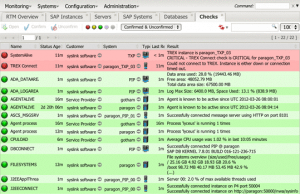Critical Monitoring
“Certain areas of your SAP landscape need to be monitoredon a regular basis to ensure reliable operation.” —SAP Administration: Practical Guide, p. 269 Galileo Press, 2011.
Monitoring is an essential part of the daily tasks of any SAP Basis Administrator. In the past, this was accomplished by logging into certain transactions once or twice a day and looking at specific parameters. As one who did this for several years, I can tell you that humans are the worst kind of resource to leverage for this. We are subject to change blindness and are easily bored by mindless repetitive tasks. Monitoring should be done exclusively by computers.
Managed Service Provider (MSP):A monitoring system on its own is just an alert generator and not much use without someone to alert to. If an alert happens and no one notices; does it make a difference? This is where many companies go awry, they set up a monitoring system, but don’t think about who will answer the alerts. Often, the internal Basis team is the wrong answer. They are too busy and, frankly, too expensive to be tasked with this. Help desk technicians are sometimes chosen for this, but they don’t know a critical SAP issue from a non-critical one—or how to fix it. Typically, they wake up or forward the issue to the Basis team. An MSP, like 1st Basismonitoring the SAP landscape remotely, is the best option for small-to-medium sized enterprises.
Every Basis support agreement 1st Basis issues includes Monitoring with our automated solution. Our system uses a .Netconnector and SAProuter(both standard methods for connecting to SAP). If a Sensory Nodeis required inside our customer’s network, it connects with our NOC Admin Node over a single TLS tunnel.
It took 3 years to build our monitoring solution after some dead ends (Nagios). Over the years we have learned what works and what doesn’t when it comes to best-practices. The main lesson was that simplicity has its own utility and reduces overhead and TCO.
Here is a smattering of the other lessons we’ve learned along the way:
- Standard SAP Connections are best
- .Net and JCo connectors
- SAProuter
- RFCs are OK, but add overhead
- Avoid systems that rely on agents
- Often a point of failure
- They add overhead to update and maintain
- They are difficult to get approval for
- Overly complicate the architecture
- Alerts are not the goal
- Too many alerts obscure actionable items
- Too much REDteaches
responders that “critical” is normal - Systems with Parent/Child validation reduce alert
noise
For companies that do not want to hire an MSP or Basis group to do their monitoring, there are a number of solutions available. These are some of the solutions we have investigated as possible replacements for our system. Buying off the shelf is a better solution than DIY.
Solution Manager 7.2:SAP has made some big improvements with 7.2 with regard to monitoring, but this is still a large-company solution and a little too DIY. While advocates claim it is “free” the cost of implementing, configuring and maintaining the solution is not and their ROI estimates are dubious. Handling the alerts requires a team of SAP Basis administrators. But, for large companies like Rockwell Automation or Bemis, a 2- to 3-year implementation and dedicated team may make sense. They report the biggest time investment is in setting up roles and security objects and getting agents configured on all systems to be monitored.
sysink Xandria:Has been in the business of providing a viable monitoring solution for about a decade. Their solution is mature and well thought out and you can tell that it was designed by Basis administrators; for Basis administrators. The company was founded in Switzerland and has only recently targeted the United States, so they are big in Europe, but somewhat new to American businesses. The founders are former Basis administrators who designed a monitoring solution of their own as well. They have enlisted another former Basis administrator with a background in monitoring system implementation as Director of Sales Engineering, Tyler Constable. He knows the product well and how to sell it to Basis administrators and MSPs. The system has two drawbacks which they assure us are correctable: it uses some agents and the UI is reminiscent of RZ20, which is not surprising given the developers are all Basis admins as well. (see my Blog on UX Matters). Here is a small sample of the UI:

These are the pros and cons for Xandria:
- Pros:
- Geared toward Basis Admins and MSPs
- Global edits to threshold templates
- Uses alert conditional logic (if/then, and/or)
- Cons:
- Uses agents, but has agent-less options
- User Interface is dated and kludgy
Foglogic:Is new to the SAP monitoring scene and is still in Beta, but they are definitely one to watch. Their UI is modern, clean and colorful and they have a strong grasp of data analytics. The solution is less tailored to SAP Basis monitoring than Xandria, but they have a lot of things right. The company was founded by Ashock Santhanamand Chandy Nilakantan, former CEOs and CTOs respectively. Together, they make a strong team and are a pleasure to deal with. Chandy’s enthusiasm for analytics is infectious. They are proud of their solution and they should be.
These are the pros and cons for Foglogic:
- Pros:
- Modern User Interface
- Strong analytics with multiple views
- Uses JCo Connector
- Cons:
- Still in Beta
- Monitoring is not real-time
- Multiple modes of data transfer instead of JSON
- Multiple connection methods including POST
The dirty little secret for Basis teams (internal and external) is that monitoring is often given a back seat to putting out fires. This becomes a vicious cycle as monitoring is meant to prevent fires. For most companies, outsourcing monitoring and remediation to an MSP (domestically) is a more economical solution. Especially for systems that require High Availability (HA) around the clock. In any case, these monitoring tools are a boon to the Basis team and by extension to the enterprise in an often neglected area. SAP calls monitoring “Critical Tasks Checks”. Our experience confirms; daily monitoring the SAP landscape is Critical.
—David Beiswenger.




